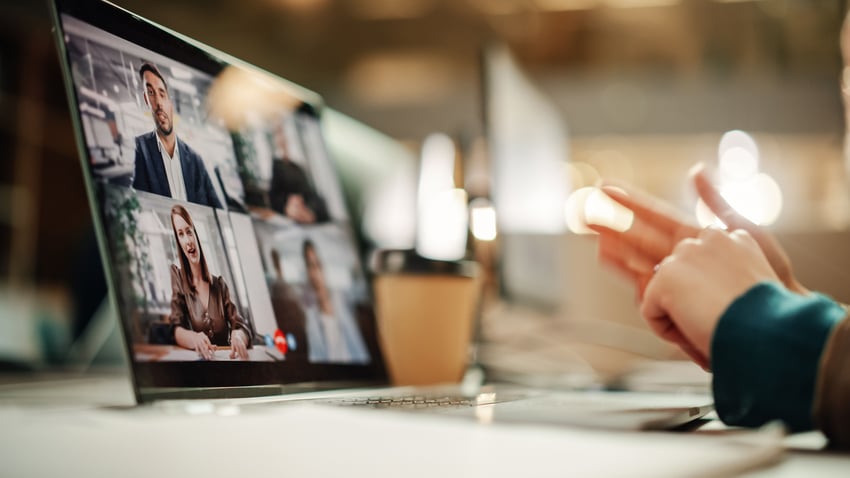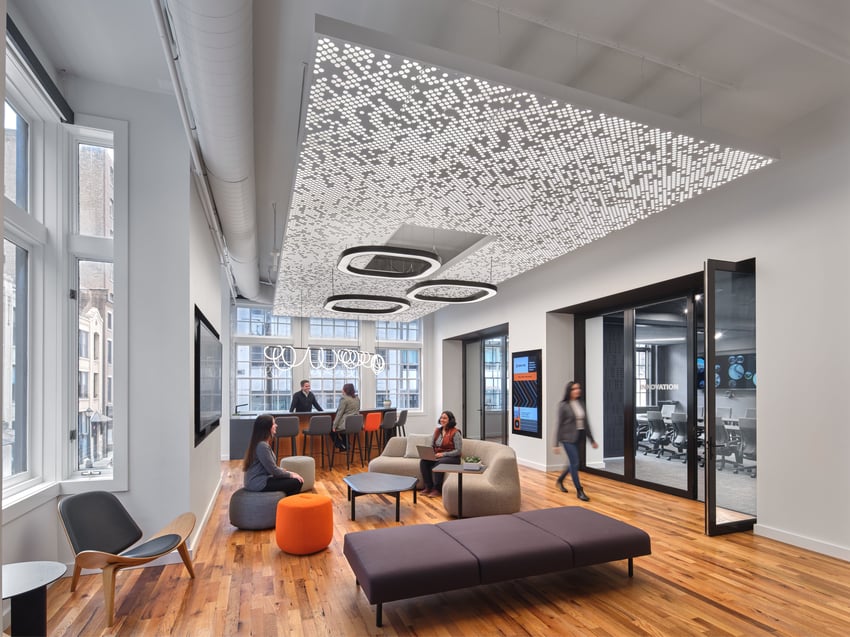Insights
Smarter Hybrid Office Design for the Modern Workforce
May 13, 2025
Digital Signage, Audio Visual, EMEA, Meeting Collaboration
The Future of Hybrid Office Design: Where Tech Disappears & Collaboration Shines
Today’s office looks and feels very different from the one we left behind a few years ago. It’s been transformed into a space that communicates culture, enables collaboration, and showcases brand identity. In the hybrid workplace model, office design has become a strategic tool, not just a floor plan.
And here’s why it matters more than ever: In a recent Diversified survey of more than 1,600 U.S. employees, 88.6% of employees said a company’s workplace structure—whether in-person, hybrid, or remote—would impact their decision to work there.
More telling? Over half (56.3%) said they’d take a hybrid or remote role with lower compensation over a fully in-person job with more pay.
In other words, your workplace structure and office environment is no longer just about operations and getting the work done—it’s about attraction, retention, and long-term engagement.
.jpeg?width=850&height=476&name=AdobeStock_638585412%20(1).jpeg)
Hybrid is Here to Stay—But the Experience Has to Evolve
We’ve found that 94.1% of employees believe hybrid work is here to stay. And while many businesses operate with a return-to-office strategy, they’re doing it through a hybrid model that embraces both remote work and in-person work.
Even organizations that have returned to in-office 5 days a week are still seeing their teams operating in a hybrid way through distributed team collaboration across office locations. That means most offices are hybrid offices and need to work harder than ever.
If the office space doesn’t offer more than a laptop on a dining table, why would hybrid workers leave home? This is where hybrid office design becomes critical.
A successful hybrid office needs to support the work life balance employees crave while providing the tools and atmosphere to encourage employees back into the building. And that starts with thoughtful office layout, collaborative spaces, and seamless technology integration.
.jpg?width=850&height=638&name=2024_04_04_NelSim10_B%20(2).jpg)
10 Essential Considerations for Hybrid Office Design
Designing a successful hybrid office means seizing the opportunity with a holistic approach aligned with how people actually work today—balancing physical space with digital experience, aesthetics with function, and flexibility with intentionality.
Here are 10 key considerations that will help you build an environment that meets the evolving needs of your hybrid workforce.
- Hybrid Is the New Normal: Hybrid work isn’t going anywhere. Your office design strategy should support both remote and in-office work with equal intention and investment, whether you’re connecting home and office, or office to office.
- Redefining the Office Footprint: It’s not about shrinking space—it’s about designing it with purpose. Ditch the rows of desks for flexible, high-impact environments that support how your teams actually work.
- Design That Disappears: Hybrid office design means seamless technology integration. Cameras, microphones, and displays should fade into the background and seamlessly integrate to create strong connection and results.
- Your Office = Your Culture Hub: The physical office acts as a social anchor for hybrid teams. Build collaboration spaces and common areas that encourage organic interaction, strengthen team bonds, and reinforce company culture.
- Connect Across the Spectrum: Support collaboration and creativity. Design private spaces for heads-down teamwork and open, casual areas that foster spontaneous connections and drive innovation across hybrid teams.
- Remote-Ready = Innovation-Ready: Ensure remote employees have equal access to collaboration tools and a consistent, high-quality experience.
- Broadcast-Ready Spaces: Transform underutilized rooms into multipurpose areas for all-hands, training, or hybrid events.
- Let Data Drive Design: Conduct a hybrid office assessment. Who uses which space, what technology, when, and why? Use data and employee feedback to inform your office layout, technology distribution and improve utilization.
- Design for Flexibility: No two employees work and use the office the same way. Prioritize modular furniture, sit-stand desks, quiet zones, and integrated smart technology to support diverse workstyles and well-being.
- Future-Ready the Experience: A majority of organizations will never have all of their people under one roof again. Design your hybrid office space to be the nucleus for in-person and remote workers–connected, adaptable, engaging, innovative and equitable.
.jpg?width=850&height=638&name=2024_04_04_NelSim09_A%20(1).jpg)
Hoteling, Flex Desks, and Hybrid Scheduling
Flexible working is the norm. In a modern hybrid work environment, employees book their time in the office strategically. They come in for team meetings, workshops, or collaborative sessions—not to sit in silence and answer emails.
This shift has made hot desks, desk booking systems, and task management tools more valuable than ever. In a hybrid workspace, these features provide structure without rigidity, allowing remote workers to plan when and how they engage with the physical office.
To keep it all running smoothly, hybrid office design now includes:
- Digital scheduling panels on conference rooms
- Integrated booking apps for hot desks
- Smart room sensors that optimize space utilization
- Automated AV setup with space booking
- Noise cancelling technology in high-traffic spaces
- Smart boards for collaboration and AI-enabled AV equipment
- Analytics on space usage, collaboration usage, individual space needs
- Wayfinding technology
- Feedback loops for employees to report issues and have a voice in future office updates
These key elements help businesses operate more efficiently and help employees work more effectively when they’re in office.
Designing Offices for Both Sides of the Screen
In today’s hybrid workplace, designing for both sides of the screen (in room and remote) means much more than hiding cameras and decluttering wires. It’s about creating a consistent, equitable, and engaging experience—regardless of where someone is sitting.
Too often, in the rush to make the office "video call ready," organizations end up building spaces that feel more like production sets than places to work. Bright lights, bulky cameras, and tech-centric layouts dominate the room, pulling focus from the human interaction they’re meant to enhance.
But real hybrid office design strikes a balance. Yes, the technology should be seamless—integrated into the space so naturally that it enhances the experience without taking it over. But just as important is how the space supports collaboration, communication, and connection for everyone involved.
That means designing for parity—not preference. Every meeting room, huddle space, and breakout zone should be set up so remote participants feel just as present and heard as those in the room.
That includes intelligent camera tracking, spatial audio, high-quality microphones, interactive displays, and intuitive controls—paired with the right furniture layouts, lighting, and acoustics to support both digital and in-person engagement.
When both sides of the screen are considered equally, your people aren’t distracted by the tech—they’re empowered by it. And when your hybrid teams can focus on the work (not the workaround), the office becomes a space where connection, collaboration, and innovation thrive.

From an Overhead Cost to an Opportunity Gain
Commercial real estate market pressures have made space utilization a boardroom-level concern. And in the hybrid work model, square footage needs to earn its keep.
This has sparked a powerful trend: turning existing office space into broadcast-ready hybrid spaces.
From executive suites to back-office break rooms, spaces are being reimagined as multipurpose environments. With AI-powered cameras, AV automation, and retractable displays, these formerly single-use spaces are transforming into dynamic platforms for hybrid collaboration. No production crew necessary. Just intelligent design and seamless technology integration that makes the most of your existing office space.
This is more than a space-saving solution. With 73% of CEOs reevaluating real estate ROI, turning physical spaces into flexible, multi-functional assets is quickly becoming the norm. It’s efficient. It’s scalable. And it’s exactly where the hybrid workplace is headed.
Creating an Office Destination, Not Just a Workplace
If you want your hybrid workforce to show up, your office can’t feel like a step back from their home setup. The only thing that might be worse than feeling isolated at home is feeling isolated while sitting shoulder to shoulder at an overcrowded hoteling desk. That means investing in the physical workspace as a destination.
When the office design supports collaboration, results, physical comfort and emotional wellbeing, it naturally boosts employee feedback, morale, and engagement.
That’s exactly what SimpleTire set out to achieve with their Brand Experience Center. Designed not just to impress clients but to inspire employees, the space blends hospitality-level aesthetics with smart, intuitive technology. Every detail—from the lighting and acoustics to the video walls and flexible layouts—is curated to make the office a place people genuinely want to be.
The result is a hybrid office environment that reflects the company’s culture, enhances team interaction, and supports both in-person work and remote collaboration.
It’s proof that when you design for experience, the office becomes more than a workplace—it becomes a destination.

The C-Suite Perspective: Offices Must Have ROI, Not Just Aesthetics
For executive decision-makers, hybrid office design is more than just a feel-good initiative. It’s about:
- Cost savings through smarter space utilization
- Retention through improved job satisfaction and work life balance
- Brand equity through elevated, professional communication tools
Whether you’re hosting a client presentation, quarterly town hall, or leadership sync, your office environment becomes part of the message.
A hybrid workspace that looks good, sounds great, and performs flawlessly? That’s an investment in perception, productivity, and performance.
Final Thoughts: The Office Needs To Evolve
Hybrid work is about working smarter. And that requires spaces—physical and digital—designed to support the way people actually work now.
By embracing intelligent hybrid office design, companies are creating flexible workspaces that:
- Encourage employees to come in
- Respect the needs of remote team members
- Support both collaborative and private tasks
- Deliver enterprise-grade communication without disrupting the aesthetic of the room
This is the hybrid workplace model done right. Not a compromise between remote and in office—but a convergence. Where the best of both worlds come together.
Because in this hybrid era, what your teams see, hear, and feel in the office environment matters more than ever.
Connect with us here if you’d like to discover more about how we can advise your hybrid office design.

Phil Rapp
With over 30 years of experience, Phil is a seasoned expert in solution architecture, experiential design, and broadcast production across corporate enterprise, live events, houses of worship, and government. He has led major design initiatives for global brands like Walmart, Amazon, and Moderna, and worked with high-profile clients including the White House, the UN, and the IOC. Phil combines certified technical expertise with a passion for creating immersive, collaborative environments. Known for his strategic vision and cross-functional leadership, he delivers innovative, scalable solutions that align with long-term goals—leaving a lasting impact on every space and story he helps bring to life.
About Diversified
Diversified is a global leader in audiovisual and media innovation, recognized for designing and building the world’s most experiential environments. Our Emmy Award-winning team specializes in delivering solutions for the most complex, large-scale and immersive installations. Serving a global clientele that includes major media organizations and retailers, sports and live performance venues, corporate enterprises, and government agencies, Diversified partners with clients to create spaces that bring people together, and keep them coming back.
INSIGHTS
News & Media
Diversified Strengthens Its Consulting and Innovation Capabilities with Strategic New Hires
Read MoreNews & Media
Diversified Builds a New Sound System for the San Francisco Giants That’s Ready to Rock
Read MoreNews & Media
Diversified Announces Flex Sourcing for Media Production and Live Event Management
Read MorePodcasts & Webinars
Why Emerging Technology Should Be About Business Goals and Not the Technology
Read MorePodcasts & Webinars
Actionable Intelligence for the Performance-Based Operations Center | On-demand
Read More

